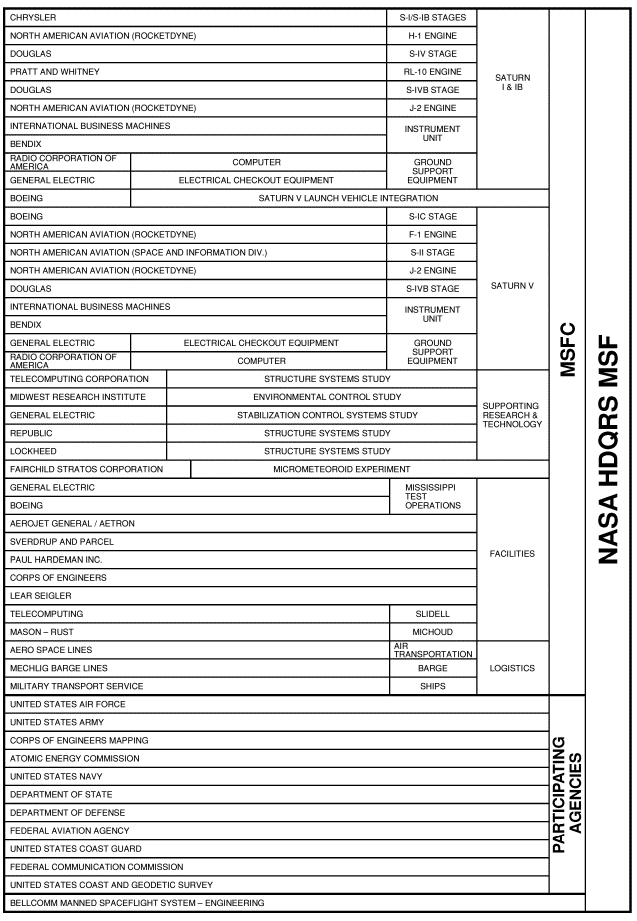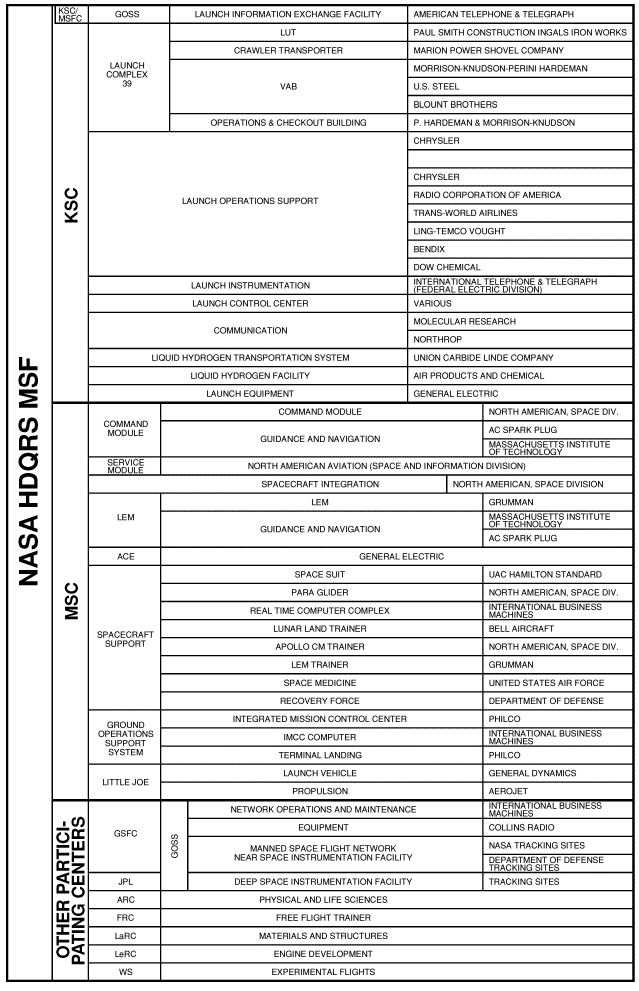
To Congress, the moon program meant money. To the American people, it was a contest of American skills pitted against the Russians or the mysteries of space. But for NASA, perhaps the biggest challenge was organization.


The government-industry team behind Apollo.
In retrospect, one of the major reasons for the program's success was the ability of a lieutenant colonel and an aerospace engineer to sit down and work out a solution to a problem that, coupled with a few thousand more solved problems, could put a man on the moon. But someone had to get the lieutenant colonel and the engineer into the same room. This carried over on a far larger scale to the thousands of items of equipment that came together on the launch pad for the moment of truth at countdown. A fitting, designed in Huntsville and manufactured in California, had to connect precisely with a fitting designed in Texas and fabricated in New York. At KSC the ground support and electrical support equipment alone totaled more than 34,000 items. Each connection was an interface - eventually the most overworked word on Merritt Island - and keeping track of every interface, bringing together all the parts into a unified whole, was called integration.
Compared to earlier programs, Apollo-Saturn required drastically more coordination. During the 1950s, the Missile Firing Laboratory's contacts were limited to the Eastern Test Range, a few support contractors, and Huntsville. The Apollo program added scores of contractors, labor unions, and government organizations. The new relationships brought conflicts. There were differences of opinion with contractors and struggles for power among the NASA centers - divisive tendencies that were balanced by the unifying urge of the lunar goal.
NASA Headquarters, unable to handle the many integration requirements of Apollo by itself, sought help from an outside source - the General Electric Company. NASA asked GE to do three things: develop checkout equipment for launch operations; assess reliability, which was largely the reduction and analysis of data from various tests; and perform the integration role. D. Brainerd Holmes, head of the Office of Manned Space Flight (OMSF), defined that term in congressional testimony:
General Electric Co.'s job is to... study and make sure that there is proper integration. By that I mean that the signals flowing across the various interfaces between pieces of equipment being built at various places in the country, are compatible. This is necessary whether it be electrical signals . . . or whether it be hydraulic flow that goes from a small quarter-inch tubing into a 2-inch pipe, or just a straight mechanical integration. 1
GE teams at the centers and at stage contractor plants would provide OMSF with the information to coordinate the various pieces of Apollo. Within OMSF, James Sloan, the Director for Integration and Checkout, monitored the contract with GE.*
Opposition to the GE contract appeared almost immediately. Directors of the Marshall Space Flight Center and the Launch Operations Directorate (LOD) believed that GE's proposed mission would infringe on center responsibilities. At Huntsville 10 April 1962, the two set up a common front to restrict GE's role. Stage contractors shared the feeling; North American, Boeing, and Douglas officials were loath to have a competitor supervise their operation. Petrone expressed opposition to the GE management role at a 15 May meeting with GE representatives. The group discussed appropriate and - as Petrone emphasized - inappropriate areas of GE activity. The following week OMSF sent Petrone's office a revised work statement more in line with LOD's position. Holmes clarified two important points at the 29 May OMSF Management Council Meeting. GE would work for the centers with Sloan's Integration Office coordinating the effort. GE would not give work directions to stage contractors.2
Controversy continued during the summer. Lengthy portions of the July and August Management Council meetings were given over to discussions of GE's proper role vis-a-vis the field contractors and stage contractors. At the Cape the Launch Operations Center (as of 1 July) prepared a list of seven tasks considered suitable for GE. The GE contract was the sole topic of discussion at a two-day meeting in late August. Officials from LOC, Marshall, and the Manned Spacecraft Center at Houston met on the 29th "to ensure that the tasks for GE written by each Center were properly and adequately integrated so as to minimize GE's overall integration role and minimize interference from [NASA] Headquarters." The three centers concentrated on checkout problems and agreed that they would not require "any overall integration guidance from either GE or Headquarters."3 Sloan and GE's top Apollo program managers joined the session on the 30th. The latter were dismayed to learn that the centers had rejected GE's checkout concept and had relegated GE to a support role.
NASA officials were in agreement about what GE should not do, but could not formalize a positive statement of the company's role. The issue generated three lengthy discussions at the 21 September Management Council meeting, and Holmes was disappointed at the lack of understanding. After a Cape visit in early November, Walter Lingle, NASA's Deputy Associate Administrator for Industry Affairs, told Holmes that the centers could not work with GE. Debus expressed surprise when Holmes called him about this report. The LOC Director admitted that, while reliability and checkout roles were set, there were still loose ends, and "there seemed to be an absence of a clear description of what GE is supposed to do." At the November Management Council meeting, there were further complaints about GE statements that suggested a management role for the company.4
Due to the broad nature of the contract and because it appeared to place the General Electric Company in the position of supervising or directing other NASA contractors, the House Committee on Science and Astronautics gave the GE contract considerable attention during the authorization hearings on the fiscal 1964 budget. In March 1963, the Manned Space Flight Subcommittee conducted hearings at GE's Daytona Beach, Florida, office.5 NASA was still undecided about GE's role three months later, and the issue, added to Congress's first attack on the Apollo program [see chapter 8-7] and the Webb-Holmes dispute [see footnote 2, ch7-8], caused considerable unhappiness. After a visit to the Daytona office in early July, von Braun and Debus thought they had reached a satisfactory arrangement for GE work at Marshall and Merritt Island. However, von Braun notified Debus on the 9th that the plan had apparently fallen through. Joseph Shea, OMSF's Deputy Director for Systems, still wanted GE's assistance in integrating Apollo activities. NASA finally resolved the dispute in August. The centers and stage contractors prevailed; GE would not manage space vehicle development. OMSF would rely on a review board to help control and integrate the Apollo program, using GE as a management consultant and data processor. GE retained the reliability assessment and checkout roles.6
* Signed on 26 February 1962, the contract eventually totaled more than $615 million, a large portion of which went into checkout equipment at KSC.


